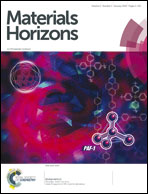Resolving the true band gap of ZrNiSn half-Heusler thermoelectric materials
Abstract
N-type XNiSn (X = Ti, Zr, Hf) half-Heusler (HH) compounds possess excellent thermoelectric properties, which are believed to be attributed to their relatively high mobility. However, p-type XNiSn HH compounds have poor figures of merit, zT, compared to XCoSb compounds. This can be traced to the suppression of the magnitude of the thermopower at high temperatures. Eg = 2eSmaxTmax relates the band gap to the thermopower peak. However, from this formula, one would conclude that the band gap of p-type XNiSn solid solutions is only one-third that of n-type XNiSn, which effectively prevents p-type XNiSn HHs from being useful thermoelectric materials. The study of p-type HH Zr1−xScxNiSn solid solutions show that the large mobility difference between electrons and holes in XNiSn results in a significant correction to the Goldsmid–Sharp formula. This finding explains the difference in the thermopower band gap between n-type and p-type HH. The high electron-to-hole weighted mobility ratio leads to an effective suppression of the bipolar effect in the thermoelectric transport properties which is essential for high zT values in n-type XNiSn (X = Ti, Zr, Hf) HH compounds.


 Please wait while we load your content...
Please wait while we load your content...